Northern Serengeti 2019: the Alternative Serengeti
Along with Kenya’s neighbouring Masai Mara, the Serengeti in Tanzania must be one of the most visited wildlife locations there is. The park’s popularity is rightly justified: it remains one of the very best safari destinations in Africa. Most might assume that this popularity comes at a price and that it is virtually impossible to escape the crowds, with every sighting of a lion, leopard or cheetah accompanied by a mass of jostling vehicles. It does not have to be like this. Pick your time and place correctly and you can be alone.
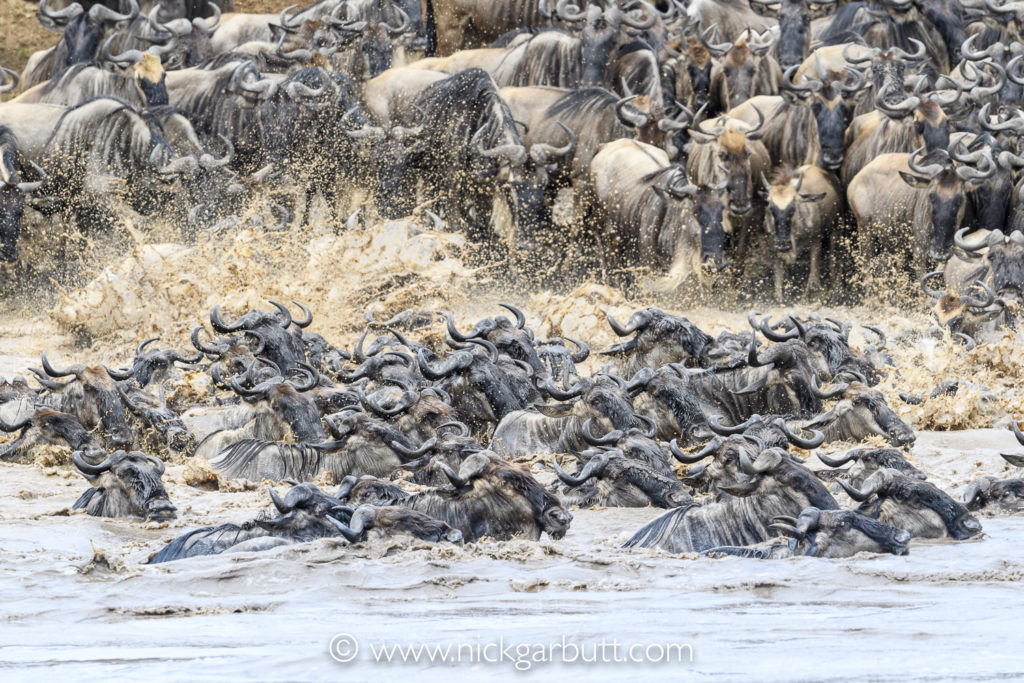
The spectacle and chaos of a Mara River crossing
The Serengeti ecosystem is a high elevation plateau (950m - 1850m above sea level) that encompasses the Masai Mara (Kenya), Serengeti National Park and much of the Ngorongoro Conservation Area (NCA) as well as surrounding ‘game controlled’ areas (all Tanzania). Within this vast area (some 30,000 square kilometres) there are the obvious ‘honey pot’ locations that attract the crowds, but there are also numerous quiet corners with very little footfall other than from wildlife.
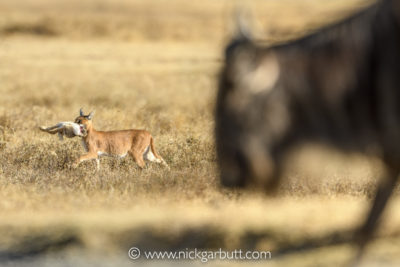
An adult caracal having just caught a Cape hare in the Ngorongoro Crater
I have always tried to time my photographic tours to avoid peak tourist periods, with itineraries that concentrate on quieter locations offering unrivalled photographic potential. In recent years, the majority of these tours have been in late March through to mid-April (peak season is February to early March) with the emphasis very much on locations in the southern Serengeti and NCA to coincide with calving time for the migrating herds of wildebeest and their feeding on the nutritious short grass plains. At this time the migrating herds move around following the rains and the prospect of fresh grazing. At any given location the plains can appear almost empty one day, with the next day bordering on the Biblical as tens of thousands of animals with thundering hooves arrive, prompted by localised downpours.
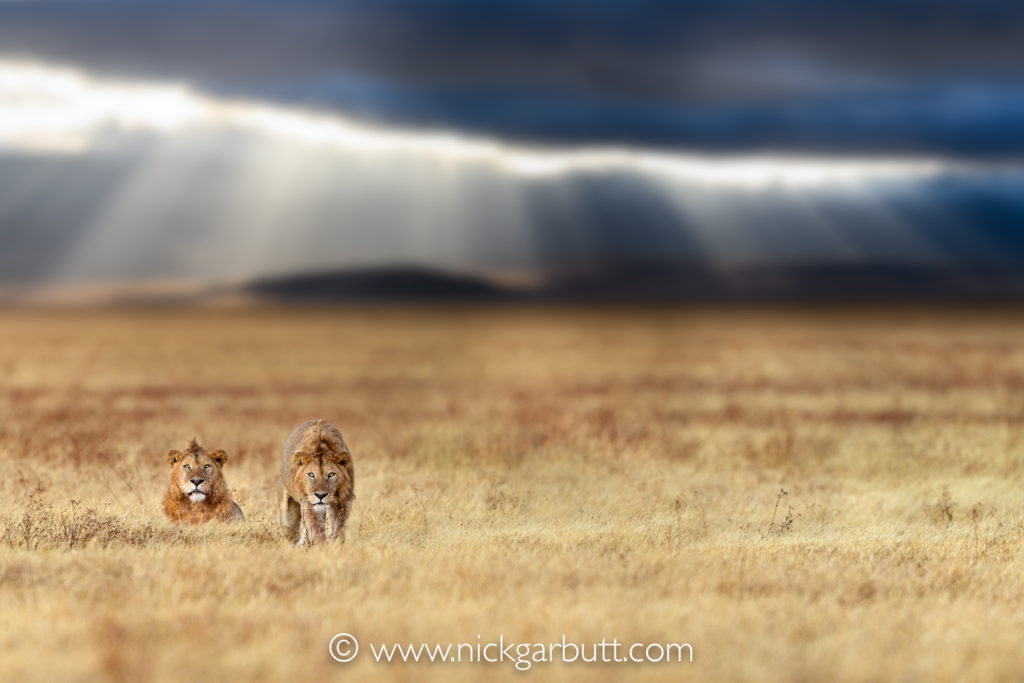
The Ngorongoro Crater always delivers something special: male lions and dramatic light
This year I decided to do something different and ran a trip in early September (2019), when the migrating herds are traditionally in the northern part of the Serengeti and across the border in the Masai Mara. One of the main attractions being the herds have to repeatedly cross the Mara River from south to north and back again in response to localised rains. These mass river crossings are spectacular ‘must see’ events, but in September the Masai Mara can become extraordinarily busy, which has always put me off visiting. However, there are long stretches of the Mara River on the Tanzania side of the border and travelling to the far north of the Serengeti offers access to numerous well-known crossing points.
This may have been the main aim of the tour, but it certainly wasn’t the sole aim. When the great herds are absent, the southern part of the Serengeti may not seem like an obvious location to visit, after all, the short grass plains between July and November are parched dry and at first glance can appear almost devoid of life. But look closely and there is a surprising amount to see. In areas where the plains meld with acacia woodland, the majority of species are resident and remain throughout the dry season. This can be a time rich in engaging photographic encounters, with hardly another vehicle to be seen anywhere.
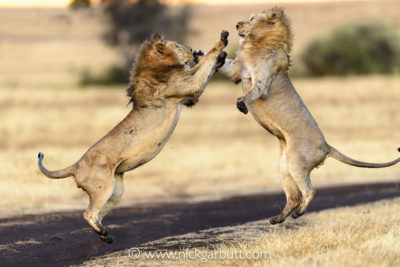
Ngorongoro Crater: first thing in the morning we found a coalition of four male lions. These two were particularly playful
Our itinerary began in the Ngorongoro Crater, which is of course a ‘honey pot’ location, but nonetheless one that offers wonderful wildlife viewing that can be done in ways that avoid masses of vehicles. We stayed for two nights in one of the lodges on the Crater rim and visited the Crater for two early morning and one afternoon session. One the first afternoon the ‘stand out’ highlight was an encounter with a caracal - we watched it stalk and pounce on a hare - and our two vehicles were the only ones there. Then the following morning, just after first light we enjoyed a fabulous encounter with a coalition of four young male lions (same litter brothers) and again we were visually on our own.
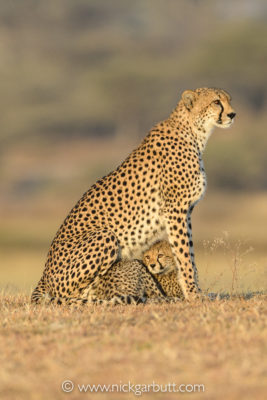
The Ndutu area can be particular rewarding for cheetah encounters
The next four days were spent in the southern Serengeti at a tucked-away location on the border of the Serengeti National Park and NCA. Acacia woodland around two lakes form focal areas where animals from the surrounding plains gather. These areas are particularly good for cats: there are resident prides of lions year-round, plenty of leopards too, although they can be characteristically difficult to find, while the plains and drainage gullies offer some of the best opportunities to see and photograph cheetahs anywhere in Africa.
During our stay this time, the cheetah encounters in particular were memorable, especially ones with a female and her three cubs around 6/7 months old. One morning we found the family shortly after sunrise, they were resting in the open in a wide gully and we manoeuvred into a
position for optimum light, approaching slowly so as not to cause them any disturbance. What followed was a sublime two hours of behaviour - mum playing with her cubs - and photography in glorious early morning light. Whenever, they moved slightly we were able to alter our position to vary the angles and get alternative shots. There were opportunities for tight portraits, wider context pictures and plenty of action as the cats played. And during the entire time there was no other vehicle to be seen.
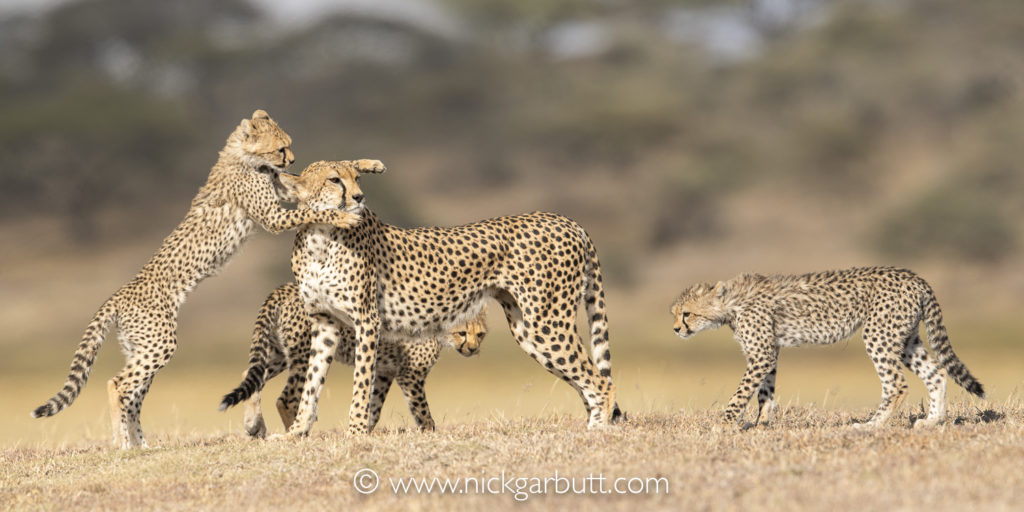
This female cheetah with three cubs provided two particularly memorable photography sessions
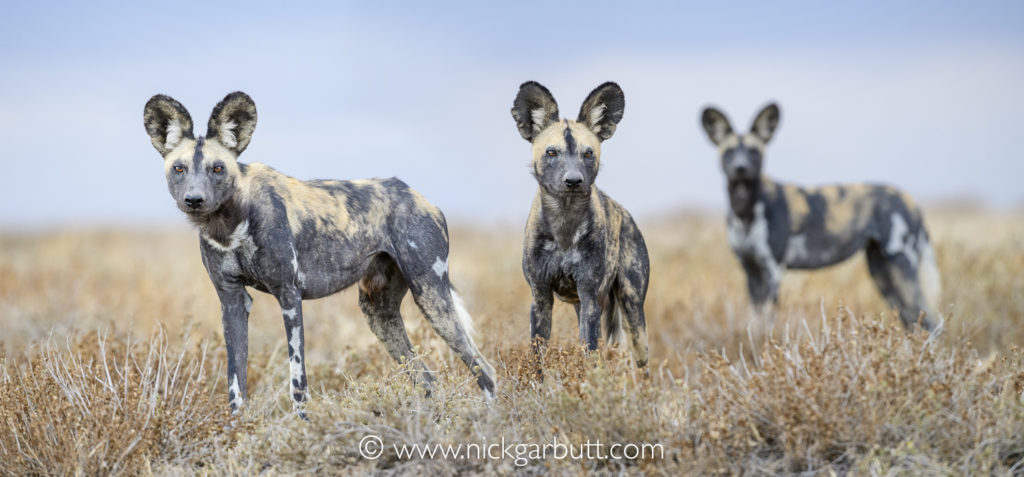
African painted dogs outside their den on the Engusoro Plain near Ndutu
All of this, of course, was leading up to the main event and finale of the trip - six nights in a mobile tented camp in the Kokatende area of the northern Serengeti. Not surprisingly, September is a peak period for the Kokatende area, so although it is nothing like as crowded as the Masai Mara can be, it is busy and the number of other vehicles in the area is noticeable. This is compounded as rules dictate everyone drives on the tracks. There is no way of predicting exactly where a river crossing may occur - it very much depends on where rains fall and where the herds are moving from and too.
On our first morning we witnessed a modest river crossing with a group of perhaps two to three hundred wildebeest moving from the south side of the river across to the north side. There were similar small crossings going the other way later in the day. It then rained very heavily overnight, especially on the south side of the river, so we were unsure what to expect as we set off from camp before dawn. A first glance at the river told us it had risen significantly overnight and was now running swiftly. As we approached the crest of a ridge before dropping down to the river at a renowned crossing point, nothing prepared us for the sight we were about to see.

Thousands of wildebeest gather on the banks of the Mara River, waiting for appropriate conditions to cross.
On the north bank of the river colossal numbers of wildebeest had gathered overnight and there were still great columns of animals heading from the Masai Mara southwards to further swell the throng. There were hundreds of thousands of wildebeest. As the morning progressed gathering animals swelled in numbers further, but the river also continued to rise, so each time a few wildebeest went to the waters’ edge to prospect a possible crossing, they quickly turned away. And still they streamed south adding to the melee that had by now reached Biblical proportions.
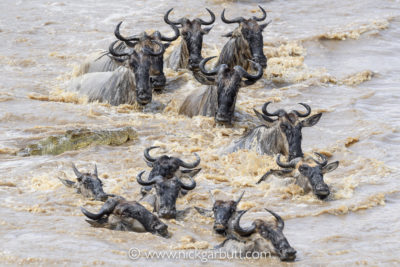
A crocodile moves into position to attack wildebeest as they cross the Mara River
We, along with a collection of other safari vehicles, waited about 400m back from the river on the south shore, hoping that a few wildebeest would at some point take the plunge and be the catalysts for the ‘cork popping from the bottle’. If this crossing happened it would be utterly epic. Alas it did not. The river continued to rise, even more wildebeest gathered, but as we progressed into late afternoon the wildebeest then began to drift away, firstly in dribs and drabs, and a little later in more substantial ‘mini-herds’. Gradually the enormous, densely packed mass of animals, was absorbed into the surrounding landscape.
The following morning, the river levels were still too high to entice a crossing. We checked several of the known crossing points where modest numbers of wildebeest were gathering, but it was clear there would be no crossing attempts until the water levels receded substantially. By mid-afternoon prospects looked more promising. River levels had certainly fallen and were continuing to drop and somehow sensing this the numbers of wildebeest returning to the river’s edge started to build. We again took up a position some 400m back from the south shore and waited. For a couple of hours or more, handfuls of animals periodically came to the river’s edge, looked like they were going to make the necessary leap, but instead backed away.

In a frenzy, wildebeest leap into the Mara River
Then late afternoon it happened. Half a dozen or so animals came to the water’s edge, one dipped a hoof, then a second. They inched forward some more, on the brink. Then one jumped in, a second jumped, a third, a fourth and in an instant the entire mass of animals began streaming down the riverbank and leaping into the river. The air was instantly filled with a cacophony from thousands of grunting wildebeest. In no time a frenzied phalanx of animals was frantically swimming across the river - a 50m width of water separating them from the ‘Promised Land’ on the far side.
Once the crossing began, we were able to move quickly down to the shoreline, choosing a point close to where the stream of animals was likely to emerge. As they swam towards us in wide-eyed panic, it was clear the current was still strong as they were being forced downstream. The first animals to make it to the south shore had drifted at least 70m downstream in the process of crossing.
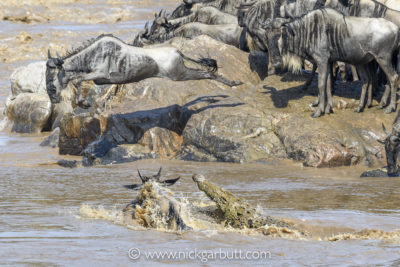
A large crocodile attacking a wildebeest as it crosses the Mara River
Within moments of the crossing beginning, huge crocodiles appeared on the scene. Some must have been hidden on the banks and slipped silently into the water, others were perhaps already in the water and lying menacingly submerged. Each crocodile moved slowly towards the wildebeest, seemingly trying to target the younger, smaller animals. At times it was remarkable to see monstrous crocodiles (5+m long) drift within touching distance of swimming wildebeest and then do nothing. On occasion the thronging mass of animals would swim and trample right over the crocodiles. But when a crocodile homed in on a single, already struggling animal, the outcome was predictable. From close range, with a swift power-packed lunge, the crocodile’s massive jaws would snap around the neck or legs of the wildebeest and in a single splash or swirl it would disappear beneath the surface. In an instant its fate sealed.
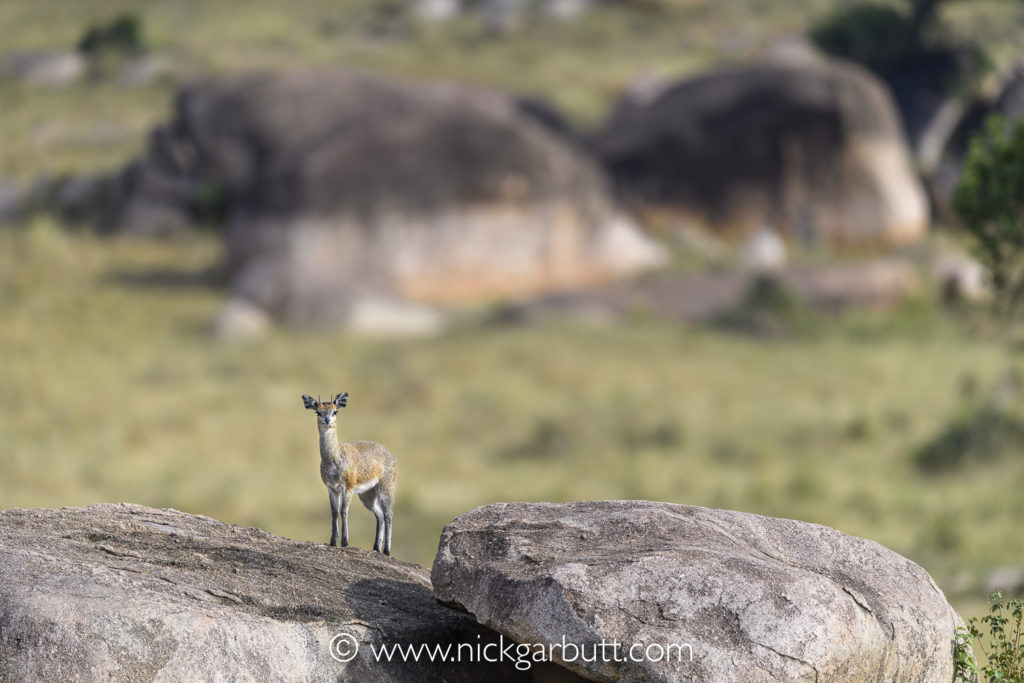
The many kopjes and rocky outcrops in the northern Serengeti provide idea habitat for klipspringers
The weather over the course of the next few days followed a predictable pattern - fine during the day, but heavy rain at night, all falling on the south side of the Mara River. This, consequently, brought more and more animals south from the Masai Mara and into the northern Serengeti. Crucially, there was little or no rain in any of the upper catchments of the river, so its levels continued to drop, and this encouraged more and more wildebeest to cross over to the southern side. Over the next five days we witnessed numerous spectacular river crossings involving tens of thousands of animals, the majority wildebeest with smatterings of zebra. Initially, we shared these crossings with good numbers of other safari vehicles, and it was necessary to jostle for a good position, but for our final two days, these diminished significantly and we were able to enjoy several crossings while virtually alone, allowing us to move and alter position according to the light and the animal movements.
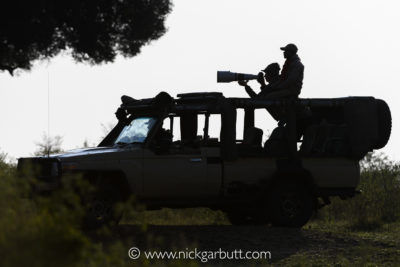
Waiting for just the right moment to take the killer shot
While our time in the northern Serengeti was dominated by maximising opportunities at river crossings, we also spent time exploring the extensive rocky outcrops or kopjes away from the river, particularly early morning when the chance of finding a leopard was highest.
Photography on Tour
This tour will next be offered in late August / early September 2021. You may wish to take a moment to think and decide if this is just the right tour for you.
Our time in the northern Serengeti very much concentrates on maximising photographic opportunities at river crossings. These are unpredictable events and it is often necessary to wait for considerable periods (several hours) at potential crossing locations, while numbers of wildebeest build up before they decide to cross. Other opportunities tend to focus on looking for cats (particularly leopards and lions) around rocky outcrops (kopjes) early in the morning.
In addition, river crossings can be dramatic, sometimes rather harrowing events to witness. Wildebeest may be taken in plain view by crocodiles, others become distressed and drown and some that successfully cross the river, then scramble up the bank and emerge with a broken leg. This really is nature red in tooth and claw.
There is a broader breadth of 'more typical' East Africa photographic opportunities around Ndudu, hence our extended stay in this area and the visit to the Ngorongoro Crater.
Bearing this in mind, this tour is perhaps better suited to those who have already been to East Africa at least once previously, and who want to concentrate on photographing more specialised events and behaviours.
